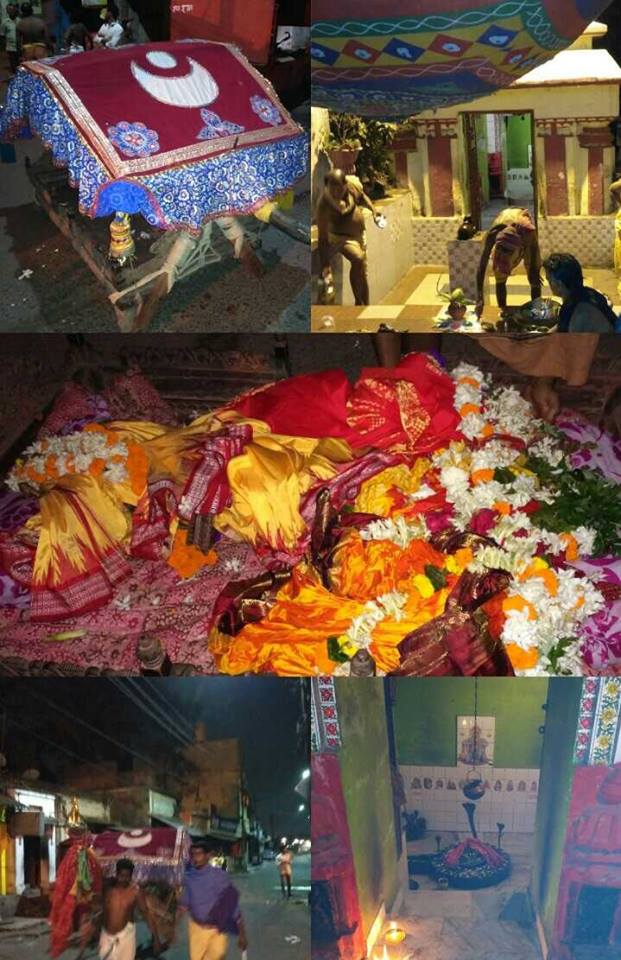Time: Chaitra Month, Shukla Pakshya Chaturdashi Tithi
Bhubaneswar, capital city of Odisha is known as the city of temples. Bhubaneswar derived its name from the city’s presiding God, Bhagwan Shiva locally known as “Tribhuvanesvara” which means “the Bhagwan of the Three Worlds”. Popularly Bhagwan Shivji is referred to as “Bhubanesvar” and after him the city is known as “Bhubaneswar”. Tribhuvanesvara is also known as Lingaraja. Lingaraja in its real terms means “King of Lingams or Lingas”. Bhubaneswar is also referred as Ekamra Ksetra (as per Ekamra Purana and other scriptures,) as Lingaraja Mahaprabhu originated under a Mango tree called Ekamra (Mango in Sanskrit is referred as Amra). Lingaraja Mahaprabhu is also described as “Swamyambhu Linga” (i.e. self-originated). This temple is dedicated to Hari Hara, a form of Bhagwan Vishnu and Bhagwan Shiva.
The temple city of Bhubaneswar has many ancient Shiva temples dotting its landscape. The most important and the ancient among them is Lingaraja Temple. In the temple, the festivals of Lingaraja Mahaprabhu are held throughout the year. A festival is called Yatra, meaning ‘journey’ of Lingaraja Mahaprabhu. The Nibandhakaras of Odisha have mentioned fourteen festivals or Chaturdasha Yatra’s. The Kalasara of Gadadhara Rajaguru speaks of the major fourteen festivals with their timing and rituals. The Sthala Mahatmyas such as the Ekamra Purana, Ekamra Chandrika and Svarnadri Mahodaya provide details about the rituals of these festivals. Damanaka Bhanjika is one of those Chaturdasha Yatras. This festival has a very unique significance in Ekamra Ksetra of Odisha i.e. especially for Bhubaneswar.
Like Mahashivaratri and Ratha Yatra, Damanaka Bhanjikais is considered to be an important festival in the Lingaraja temple. It is celebrated in the month of Chaitra on Shukla Chaturdashi (fourteenth day of the bright fortnight). It is also celebrated when Chaturdashi and Purnima Tithis fall on the same day.
The meaning of Damanaka means Dayana. Dayana is one type of scented Tulsi plant (mostly found in southern part of India which looks like Tulsi plant, but the scent of the leaves is different). This plant has various Ayurvedic medicinal properties associated with it, so it is believed that by receiving it from Tirtharaja of Tirthesvara (Linga inside Tirthesvara is known as Tirtharaja), Lingaraja Mahaprabhu gets himself cured from illness.
Viddhis
On the Chaturdashi Tithi, Chalanti Pratima’s i.e. Vigraha’s of Lingaraja Mahaprabhu, Gopalini, Karttikeya, Nandikeswar return to the temple after completion of the Rukuna Ratha Yatra. This is followed by some viddhis and puja performed inside the temple on the occasion of Shiva Chaturdashi. After these viddhis Chaturdashi Mahadweepa is taken to the top of the temple.
After this viddhi, Chalanti Pratimas of Lingaraja Mahaprabhu, Devi Parvati, Vasudeva and Devi Rukmini are again taken in a procession in the Vimana (Palanki) to Tirthesvara Temple amidst musical instruments, light etc. On that Chaturdashi Tithi one Dayana plant is worshipped by keeping it on the Tirthesvara Linga. Before all Vigrahas reach in the procession to Tirthesvara Temple, small Khatulis (Singhasana made of wood) are being kept on the Mandapa in front of Tirthesvara Temple. All the Vigraha’s are made to sit on these Khatulis bringing them from the Vimana (Palanki). After that the Puja Panda of Lingaraja Temple does the Kalasha Puja and establishes it and offers Prasada. Simultaneously, Tirthesvara Linga is also worshiped.
Bheta Arati “Alati”
After Prasada is offered to both Tirthesvara Linga and Chalanti Pratima of Lingaraja Mahaprabhu, Chalanti Pratima is taken inside the Jagamohana of Tirthesvara Temple and made to seat near the Linga. This ritual of face to face meeting of Chalanti Pratima of Lingaraja Mahaprabhu and Tirthesvara is known as “Bheta”.
Then the Puja Panda does Shodasa Upachara Puja of Tirthesvara followed by Arati. After that the same viddhi is performed for Chalanti Pratima of Lingaraja Mahaprabhu. This viddhi of Arati is known as “Bheta Arati”.
After “Bheta Arati”, Chalanti Pratima of Lingaraja Mahaprabhu return to the Khatulis present on the Mandapa in front of Trithesvara Temple along with the Dayana plant and after that are taken to the Vimana’s placed outside the Tirthesvara Temple. Then the Chalanti Pratima returns to the Lingaraja Temple along with the Dayana plant.
As per folklores and belief the person who visualizes Chalanti Pratima of Lingaraja Mahaprabhu on Vimana during Damanaka Bhanjika Yatra will receive the blessings from Mahaprabhu and is discharged of his/her sins.
If in any year, the Chaturdashi Tithi and Purnami (Purnima) Tithi are on the same day, Chalanti Pratima’s stays over the Ratha up to Purnima tithi and returns to the temple on Pratipada Tithi of Krushna Pakhsya. In that year, the Chalanti Pratima of PanchabakraPrabhu is taken to Tirthesvara on the auspicious occasion of Damanaka Bhanjika instead of Vigraha of Lingaraja Mahaprabhu.
“I am really thankful to Kar Nana (Sanskrit scholar and Pujari) for his knowledge on our scriptures and also for guiding me. I am also thankful to my parents for their valuable help in translating regional texts.”
References
- Ekamra Purana; 69.4-20
- Ekamra Chandrika; Ch 11.117-132
- N. Dhal ,”A Note on the Sacred Rituals at Ekamra Ksetra (Bhubaneswar)”, p. 4.
- Pandit MangobindaMahasupakar, “Bhubaneswar Aitihya”, p. 138, 8.6
